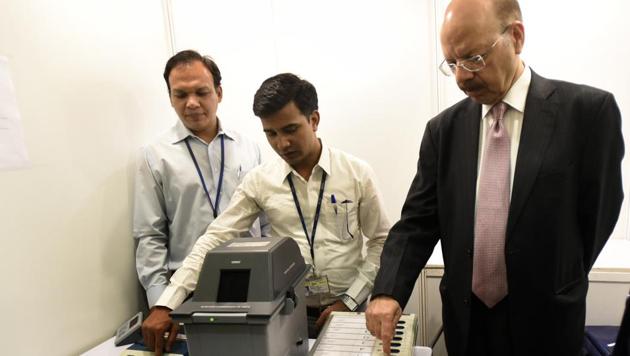EVM challenge: How Indian machines stack up against those used abroad
Indian EVMs have several layers of checks and store data internally while those used in Western countries needed CDs to transfer data, compromising security, says the poll panel.
Beginning June 3, the election commission has invited political parties to prove that electronic voting machines (EVMs) can be tampered with.

Several parties, led by Arvind Kejriwal’s Aam Aadmi Party, have claimed that the BJP’s victory in a string of state and civic elections was a result of the manipulation of EVMs and not a reflection of the voter sentiment.
The BJP and the election commission have both denied the charge.
The poll panel while announcing the EVM challenge on Saturday again said the EVMs used by it were tamper-proof and comparing them with the ones discarded by several Western countries was unfair as the systems and technology were different.
“EVMs used in The Netherlands, Ireland and Germany were privately manufactured and had no independent certification system unlike a very robust verification and certification system… in case of ECI (election commission of India) EVMs,” chief election commissioner Nasim Zaidi said.
Here is how Indian EVMs are different:
What sets India apart
Data from the NEDAP machines used in the Netherlands is transferred through CDs but the Indian EVMs store data internally. Indian EVMs are stand-alone, direct-recording machines with no possibility of network connectivity with citizens casting their votes at an assigned polling station. Basically it means that the machine can’t be accessed remotely or be hacked into. This feature, EC officials say, makes them impossible to manipulate.
The EVMs are manufactured by two PSUs -- ECIL and BEL -- with no third party involved. The software is written in-house. Chips were so designed that if tampered with, machines become inoperable, poll panels officials said.
The Netherlands
Information provided by the EC shows that the machines used in The Netherlands between 1990 and 2007 were manufactured by a private Dutch company, NEDAP (Nederlandse Apparaten Fabriek NV).
In 2006, the government ordered an independent test of the machines. Two independent commissions were also asked to review the security and reliability features.
The machines were discontinued after the commissions said the ministry responsible for holding polls didn’t have enough technical knowledge about the machines, forcing officials to depend on external actors for conducting elections. Technology vendors became part of the decision-making process and the ministry was not in a position to exercise effective oversight.
The Dutch organization for applied scientific research said the machines were following “outdated standards” that were not immune to security threats.
Germany
In Germany, the NEDAP-manufactured e-voting machines were used between 2005 and 2009.
The Bundesverfassungsgericht, or the federal constitutional court of Germany, discontinued the machines in 2009, saying they violated the principle of the public nature of elections. The constitution clearly laid out all steps in the elections process were subject to public scrutiny unless said otherwise, the court said.
Ireland
Ireland used NEDAP machines from 2002 to 2004. Two independent commissions concluded that the machines could not be used because of inadequate safeguards, insecure transfer of data through CDs and inconsistencies in physical security of machines across constituencies.
The United States of America
In 2000 the voting method was reviewed and direct recording electronic (DRE) systems introduced after a dispute in the presidential election.
DRE systems use “one of three basic interfaces (pushbutton, touch screen or dial)” through which “voters record their votes directly into computer memory. Voters’ choices are stored in DREs via a memory cartridge, diskette or smart card…Some DREs can be equipped with Voter Verified Paper Audit Trail (VVPAT) printers...”
As many as 27 states use direct recording machines. Fifteen of these use paper audit trails. The other voting methods include: optical scan paper ballot systems, ballot-marking devices and the punch card ballot.
Get Current Updates on India News, Election 2024, Arvind Kejriwal News Live, Bihar Board 10th Result 2024 Live along with Latest News and Top Headlines from India and around the world.




